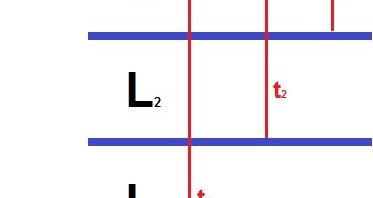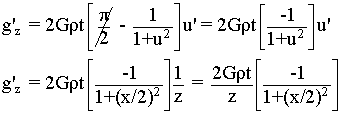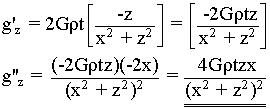Geophysics 559-Geophysical Interpretation
In class midterm will be mostly multiple choice; but there will be also written questions.
Disclaimer: While every reasonable effort is made to ensure that the information provided is accurate, no guarantees for the currency or accuracy of information are made. It takes several proof readings and rewrites to bring the quiz to an exceptional level. If you find an error, please contact me as soon as possible. Please indicate the question ID-Number or description because server may randomize the questions and answers.
Geophysics 559 (GOPH 559) Midterm
Congratulations - you have completed Geophysics 559 (GOPH 559) Midterm.
You scored %%SCORE%% out of %%TOTAL%%. With incorrect multiple tries your score is %%PERCENTAGE%%
Your performance has been rated as %%RATING%%
Question 1 |
A | Limestone |
B | Shale |
C | Igneous rocks |
D | Sandstone |
E | Salt |
Question 2 |
A | resolution of layers with extremely small difference in densities. |
B | effect that the distance between a seismic source and a receiver (the offset) has on the arrival time of a reflection. |
C | reduction of seismic resolution as a result of smaller variation in densities of different layers and the depth to the reflection surface. |
D | density contrast between two layers adjacent to each other. |
Question 3 |
A | Speed or velocity |
B | Density of formations |
C | Vibrations |
D | Depth of reflectors |
Question 4 |
A | Foliations |
B | Faults |
C | Reefs |
D | Folds |
Question 5 |
A | low |
B | Not enough information to answer the question. |
C | high |
Question 6 |
A | 100 years. |
B | 20 years. |
C | 50 years. |
D | 150 years. |
Question 7 |
A | It will be a increased reading by a factor of 2πGρt. |
B | It will be a reduced reading by a factor of 2πGρt. |
C | It will be a increased reading by a factor of 4πGρt. |
D | It will be a reduced reading by a factor of 4πGρt. |
Question 8 |
A | Transmitted wave |
B | Refracted arrival |
C | Direct wave |
D | Critically refracted arrival |
E | Guided wave |
Question 9 |
A | Porosity |
B | Temperature |
C | Pressure |
D | Gravity |
E | Buoyancy |
Question 10 |
A | Along the plane of the fractures. |
B | It depends on the rock type and the formation. |
C | Across or perpendicular to fractures. |
D | Along any angle between the fractures and natural permeability pathways. |
Question 11 |
A | Oil and gas exploration |
B | Hydrological research (drinking water, fresh water) |
C | Mineral exploration |
D | Identification of basement features |
Question 12 |
A | 512.2 Hz |
B | 322.9 Hz |
C | 166.7 Hz |
D | 255.8 hz |
Question 13 |
A | A very good reservoir with 100% pure oil and no impurities or other type of fluids. |
B | A very good reservoir with no significant traps. |
C | Gas at the very top of the reservoir followed by oil and water as the depth increases. |
D | Oil at the very top of the reservoir followed by gas and water as the depth increases. |
Question 14 |
A | A spring that has no length but only diameter. |
B | A spring that is under maximum tension (maximum stretch). |
C | A theoretical name given to springs that are not being stretch. |
D | A theoretical name given to springs that do not obey its spring constant, k. |
E | A theoretical name given to springs that obey its spring constant, k. |
Question 15 |
A | Principle of Reciprocity |
B | Snell's Law |
C | Refraction Law |
D | Fermat's Principle |
Question 16 |
A | 0 - 200 degree Celsius |
B | 250 - 350 degree Celsius |
C | 20 - 200 degree Celsius |
D | 200 - 350 degree Celsius |
E | 50 - 150 degree Celsius |
Question 17 |
A | Normal Moveout |
B | Convolution |
C | Reciprocity |
D | Deconvolution |
Question 18 |
A | ...wavelength (and wavelength only). |
B | ...similarities between seismic events. |
C | ...time (and time only). |
D | ...frequency (and frequency only). |
Question 19 |
A | The location closest to the equator. |
B | The location with the highest elevation and the lowest latitude. |
C | The location between the equator and the poles (middle). |
D | The location with the lowest elevation and the highest latitude. |
E | The location closest to the poles. |
Question 20 |
A | Advanced well-logging data obtained through a combination of core samples and seismic data. |
B | Density measurements obtained through seismic data. |
C | Comprehensive understanding of the regional Geology. |
D | 2D and 3D structural modeling of the area. |
Question 21 |
A | Gravity survey |
B | Seismic interference |
C | None of the above |
D | Acoustic impedance |
E | Magnetic survey |
Question 22 |
A | Free Air and Slab effects |
B | Slab and Terrain effects |
C | Free Air and Terrain effects |
D | Latitude and Slab effects |
E | Latitude and Free Air effects |
Question 23 |
A | Increasing spatial sampling. |
B | Increase in seismic frequency. |
C | Having a frequency below the Nyquist value. |
D | Decrease in period. |
Question 24 |
A | 1500 m/s |
B | 200 m/s |
C | 6000 m/s |
D | 4000 m/s |
E | 10 m/s |
Question 25 |
A | A specific area of a specific Formation in which the temperature is between 50 - 150 degree Celsius. |
B | A highly conductive (high effective porosity) stratigraphic or a rock body that is capable of containing hydrocarbon. |
C | A body of rock that is capable of containing hydrocarbons due to perfectly impermeable barrier. |
D | A Geologic area that is capable of containing hydrocarbons due to relatively impermeable barrier. |
Question 26 |
A | Change in dip angles. |
B | Change in density. |
C | Change in lithology. |
D | Fractures within the formation. |
Question 27 |
A | greater than 10 |
B | greater than 30 |
C | less than 40 |
D | greater than 50 |
E | less than 5 |
Question 28 |
A | Incident and Refractory rays |
B | Gravitational and Magnetic forces |
C | Gravitational and Potential energy |
D | Spring Constant and magnitude of gravity |
Question 29 |
A | The head wave only travels in the first medium. |
B | The direct wave has a sinusoidal wave form while the head wave does not. |
C | The head wave travels further than the direct wave, but it has a higher velocity. |
D | The direct wave travels faster than the head wave. |
Question 30 |
A | Cannot be answered with the given information. |
B | Gas |
C | Oil |
D | Water |
Question 31 |
A | 90 degree Celsius |
B | 150 degree Celsius |
C | 70 degree Celsius |
D | 200 degree Celsius |
E | 50 degree Celsius |
Question 32 |
A | Dry gas preservation limit |
B | Oil floor |
C | Oil window |
D | Wet gas preservation limit |
← |
List |
→ |
| 1 | 2 | 3 | 4 | 5 |
| 6 | 7 | 8 | 9 | 10 |
| 11 | 12 | 13 | 14 | 15 |
| 16 | 17 | 18 | 19 | 20 |
| 21 | 22 | 23 | 24 | 25 |
| 26 | 27 | 28 | 29 | 30 |
| 31 | 32 | End |
Credits: Based on the excellent class notes provided by, Dr. Laurence Lines during Winter 2015.
FAQ | Report an Error
If you get a question wrong, you can still click on the other answers. This will open up hints and explanations (if available), which will provide additional information.
Given the faulted slab equation, 




